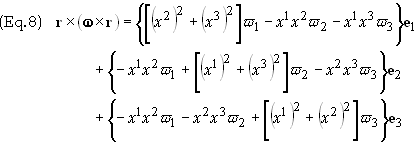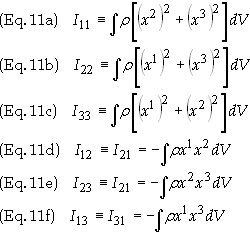Moment
of Inertia Tensor
Back
to Physics World
Back to Classical Mechanics
The angular momentum L of a point particle of momentum p = mv located at r is defined as
![]()
This
relation is defined relative to the origin of the coordinate system. Given
another coordinate system there will be another value of the particle’s
angular momentum. The angular velocity w
of the particle is related to the particle’s v velocity and position r
as
![]()
L
may be now expressed in terms of w
as
![]()
For a
system of point particles the total angular momentum is defined as

For a
rigid body having a continuous mass distribution of mass density r
the mass of an infinitesimal element of the body is given by dm = r
dV. The angular momentum of this element is then
![]()
The
total angular momentum of a rigid body is then found to be
![]()
Evaluate
this in Cartesian coordinates. Let e1,
e2, and e3
be unit vectors in the direction of the x, y, and z-axes
respectively. In terms of these basis vectors
![]()
The
vector under the integral sign in Eq. (6) now becomes

Substituting
into Eq. (6) we obtain

Define
the matrix moment of inertia tensor, I, whose components Ijk
= Ikj
may be arranged in matrix form as

where

The
total angular momentum may now be expressed entirely in terms of w
and I as
![]()
This can
be simplified to

Kinetic
Energy
An
expression for the kinetic energy of a rigid body rotating at constant angular
momentum can be given in terms of the inertia tensor defined about in Eq. (11).
The total kinetic energy of such a body is defined as
![]()
The term
w´r
is given in Eq. (7) above. The magnitude squared of this quantity has the value

Rearranging
terms gives

Substitute
this result into Eq. (14) to obtain

Substituting
the components of the moment of inertia tensor, defined in Eq. (11)

Substituting
the double summation symbol so as to simplify Eq. (18) gives

Back
to Classical Mechanics
Back to Physics World